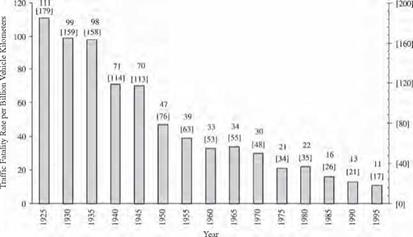CONCEPTS AND BENEFITS OF ROADSIDE SAFETY
The roadside is defined as that area beyond the traveled way and shoulder. Thus, roadside safety is concerned with treatments that minimize the likelihood of serious injuries when a vehicle runs off the roadway.
Roadside safety design has received particular emphasis since the 1960s. The increased awareness of its importance and the development of improved safety concepts and devices have contributed significantly to improved safety. As shown in Fig. 6.1, the traffic fatality rate expressed in terms of driven distance has declined to one-third of that in the mid-1960s. Many factors have contributed to the declining rate, including safer vehicles (occupant restraints, door beams, crash energy management, etc.) and improved roadways (intersection geometry, superelevation, grade separation, etc.). However, roadside improvements have played a key role in reducing fatalities.
Cost-effective roadside safety concepts and features must be incorporated in both new construction and in rehabilitation projects.
|
FIGURE 6.1 Traffic fatality rate continues to decline. (From Roadside Design Guide, AASHTO, Washington, D. C., 2002 and 2006, with permission) |
Roadside safety must be addressed because a significant number of vehicles inevitably leave the roadway. There are a variety of reasons for this, such as:
• Driver fatigue or inattention
• Excessive speed
• Driving under the influence of alcohol or drugs
• Collision avoidance
• Roadway condition (ice, snow, rain)
• Vehicle component failure
• Poor visibility
To reduce the severity of accidents involving these errant vehicles, the roadside should have relatively flat slopes and be free of fixed objects. What is known as the forgiving roadside concept has generally become an integral part of highway design criteria. Obstacles most often responsible for roadside fatalities include
• Trees and shrubs
• Utility poles
• Culverts and ditches
• Curbs and walls
• Sign and luminaire supports
• Bridge piers and abutments
Design options often employed for addressing a roadside obstacle include
• Removing the obstacle
• Redesigning the obstacle so it can be safely traversed
• Relocating the obstacle
• Using breakaway devices
• Shielding the obstacle with a barrier or crash cushion
• Delineating the obstacle
As with virtually all highway construction, funds for safety improvements are limited, and thus, emphasis must be given to improvements that are cost-effective and offer the greatest opportunities for safety enhancement. Some features such as breakaway supports and bridge railings are routinely included on the basis of a subjective analysis of obvious benefits. In other cases, where alternatives exist, benefit-cost and value engineering studies should be used to aid in rational decisions. Benefits include expected reduction in accident costs, including the cost of personal injuries and property damage, based on the expected reduction in number and severity of accidents associated with the improvement. Costs include direct construction cost and maintenance. The study must be based on a specific project life so that benefits and costs can be annualized. This involves the application of discount rates and life-cycle costs as discussed in Chap. 10. The computer program Roadside Safety Analysis Program (RSAP) is available to aid in the selection process. Contact the Transportation Research Board, NCHRP, 2101 Constitution Ave. NW, Washington, D. C. 20418.







Leave a reply